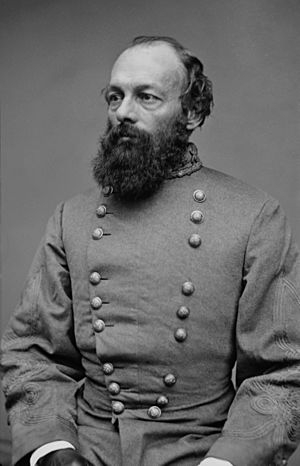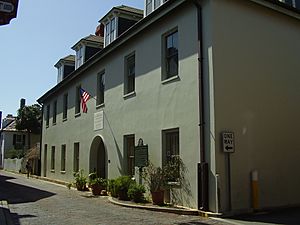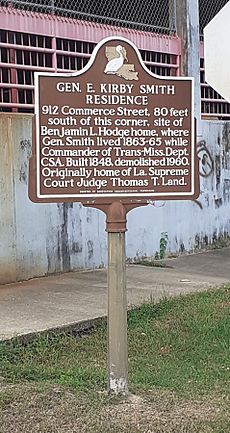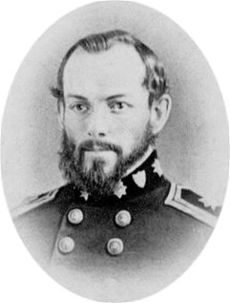Edmund Kirby Smith facts for kids
Quick facts for kids
Edmund Kirby Smith
|
|
|---|---|

Smith in uniform, c. 1862
|
|
| Nickname(s) | "Ted", "Seminole" |
| Born | May 16, 1824 St. Augustine, Florida, U.S. |
| Died | March 28, 1893 (aged 68) Sewanee, Tennessee, U.S. |
| Buried |
University Cemetery,
Sewanee, Tennessee, U.S. |
| Allegiance | |
| Service/ |
|
| Years of service |
|
| Rank |
|
| Commands held |
|
| Battles/wars | Mexican–American War American Civil War |
| Signature | |
General Edmund Kirby Smith (May 16, 1824 – March 28, 1893) was a high-ranking officer in the Confederate States Army during the American Civil War. He led the Trans-Mississippi Department, a large area including states like Arkansas, Missouri, and Texas, from 1863 to 1865. Before the Civil War, Smith served as an officer in the United States Army.
Smith was injured at the First Battle of Bull Run. He also played an important role in the Confederate Heartland Offensive, which was the Confederacy's attempt to take control of Kentucky in 1862. He became the commander of the Trans-Mississippi Department in January 1863. This region covered most of the actions west of the Mississippi River and east of the Rocky Mountains. In 1863, Smith sent troops to try and help during the Siege of Vicksburg, but they were not successful.
After the United States took control of Vicksburg in July 1863, the Trans-Mississippi Department was cut off from the rest of the Confederacy. It became almost like its own country, sometimes called "Kirby Smithdom." In the Red River Campaign of Spring 1864, Smith led Confederate troops to victory against a combined U.S. Army and Navy attack.
On June 2, 1865, Smith surrendered his army in Galveston, Texas. He was the last general with a large group of soldiers to surrender. He quickly left for Mexico and then Cuba to avoid being arrested. His wife helped him arrange his return when the U.S. government offered forgiveness to those who promised loyalty to the United States. After the war, Smith worked in the telegraph and railway industries. He also taught mathematics at the University of the South in Tennessee. He loved studying plants and gave his collection to the University of Florida.
Contents
Early Life and Education

Edmund Kirby Smith was born in 1824 in St. Augustine, Florida. He was the youngest child of Joseph Lee Smith, a lawyer, and Frances Kirby Smith. His parents were from Connecticut and moved to Florida in 1821. His father became a judge in the new Florida Territory, which the U.S. had just acquired from Spain.
Even though he was interested in plants and nature, Smith's parents sent him to a military boarding school in Virginia in 1836. They strongly encouraged him to have a military career. He later joined the United States Military Academy, also known as West Point.
In 1841, Smith started at West Point and finished four years later in 1845. He was ranked 25th in his class. While there, he was nicknamed "Seminole" after the Seminole people of Florida. On July 1, 1845, he became a second lieutenant in the 5th U.S. Infantry.
Early Military Career
During the Mexican–American War, Smith served under General Zachary Taylor and General Winfield Scott. He earned promotions for his bravery in battles like Cerro Gordo and Contreras. His older brother, Ephraim Kirby Smith, also served with him and sadly died from injuries in 1847.
After the war, Smith became a captain in the 2nd U.S. Cavalry in 1855, mainly serving in Texas. During this time, a young man named Alexander Darnes worked as his valet. Smith also taught mathematics at West Point from 1849 to 1852. He enjoyed this time and continued his hobby of studying plants. He even gave some of his plant collections and reports to the Smithsonian Institution.
Smith returned to leading troops in the Southwest. In 1859, he was wounded in his leg while fighting Comanche people in Kansas. When Texas decided to leave the United States in 1861, Smith, who was now a major, refused to give up his command. However, on April 6, he resigned from the United States Army to join the Confederacy.
American Civil War
On March 16, 1861, Smith joined the Confederate States Army as a major. He quickly rose through the ranks. On June 17, 1861, he became a brigadier-general and led a group of soldiers at the First Battle of Bull Run on July 21. He was badly wounded in the neck and shoulder during this battle. After recovering, he returned to duty as a major-general in the Army of Northern Virginia.
Army of Tennessee
In February 1862, Smith was sent west to command a part of the Army of Mississippi. He worked with General Braxton Bragg in the plan to invade Kentucky. Smith won a big victory at the Battle of Richmond, Kentucky, on August 30, 1862. On October 9, he was promoted to lieutenant-general. He received special thanks from the Confederate Congress for his actions at Richmond.
Trans-Mississippi Department

On January 14, 1863, Smith was put in charge of the Trans-Mississippi Department. This huge area included Arkansas, Missouri, Texas, western Louisiana, Arizona Territory, and the Indian Territory. He stayed west of the Mississippi River for the rest of the war, often based in Shreveport, Louisiana.
As U.S. forces gained control of the Mississippi River, Smith's department became cut off from the Confederate capital in Richmond, Virginia. He had to lead this nearly independent area of the Confederacy, which brought many challenges. This region became known as "Kirby Smithdom."
In the spring of 1864, General Taylor, who was under Smith's command, defeated General Banks at the Battle of Mansfield during the Red River Campaign on April 8, 1864. After another battle, Smith sent half of Taylor's army north to stop a U.S. invasion of Arkansas. This decision caused a lot of disagreement between Smith and Taylor.
With the pressure eased in the north, Smith tried to send help to the east side of the Mississippi River. However, the U.S. Navy controlled the river, making it impossible. Instead, he sent Major-General Sterling Price on an unsuccessful invasion of Missouri. Smith continued the war west of the river through smaller attacks and guerrilla warfare.
Smith became a full general on February 19, 1864. He negotiated the surrender of his department on May 26, 1865. He was the last full general to surrender, signing the terms in Galveston, Texas, on June 2, almost eight weeks after Robert E. Lee's surrender. He immediately left the country for Mexico and then Cuba. He returned to the United States later that year and took an oath of loyalty on November 14, 1865.
Later Life
After the war, Smith worked in the telegraph business and in education. From 1866 to 1868, he was the president of the Atlantic and Pacific Telegraph Company. When that business didn't work out, he started a school in New Castle, Kentucky, which he ran until it burned down in 1870.
In 1870, he became the chancellor of the University of Nashville, a position he held until 1875. In 1875, Smith became a professor of mathematics and botany at the University of the South in Sewanee, Tennessee. He gave some of his plant collections from these years to other universities and the Smithsonian Institution. He kept in touch with other botanists. He taught at the University of the South until he passed away from pneumonia in 1893. He was the last surviving full general from the Civil War. He is buried in the University Cemetery at Sewanee.
Personal Life
In August 1861, Smith met Cassie Selden (1836–1905). They married on September 24. While he was recovering from his injury at the First Battle of Bull Run, he still found time to spend with her. Cassie wrote to him in 1862, asking what to name their first child, who was later named Caroline.
The couple briefly reunited when Cassie joined her husband in Shreveport, Louisiana in February 1863. In the spring of 1864, she moved to Hempstead, Texas, where she stayed until the war ended. After the war, Cassie traveled to Washington to help her husband return to the United States from Cuba.
In 1875, Smith became a professor at the University of the South in Sewanee, Tennessee. The family lived happily there. They had five sons and six daughters: Caroline, Frances, Edmund, Lydia, Nina, Elizabeth, Reynold, William, Josephine, Joseph Lee, and Ephraim.
Reynold, William, Joseph, and Ephraim all played for the Sewanee Tigers football team. Joseph and Ephraim were both recognized as top football players in the South. Joseph was part of the famous 1899 "Iron Men" team.
Legacy
- A dormitory building at LSU in Baton Rouge, Louisiana was named Edmund Kirby Smith Hall. It was taken down in 2022.
- A painting of Edmund Kirby Smith by Cornelius Hankins is displayed at Vanderbilt University.
- In 1922, the state of Florida placed a statue of General Smith in the National Statuary Hall Collection at the United States Capitol in Washington, D.C. In 2018, Florida decided to replace this statue with one of African-American civil rights activist Mary McLeod Bethune. The Smith statue was planned to move to the Lake County Historical Museum. However, after strong opposition from residents and local leaders, the Lake County commissioners voted against accepting the statue in 2020.
- At the University of the South in Sewanee, Tennessee, where he taught, a place called Kirby-Smith Point honors him.
- The Kirby-Smith Chapter of the United Daughters of the Confederacy in Sewanee and the Kirby-Smith Camp 1209, Sons of Confederate Veterans, in Jacksonville, Florida, are named after him.
- Kirby Smith Middle School in Jacksonville was named for him.
- During World War II, a ship called the SS E. Kirby Smith was built in 1943 and named after him.
- In 2004, a life-sized statue of Kirby Smith and Alexander Darnes was created by Maria Kirby Smith, a great-granddaughter of Smith. It is located in the courtyard of the Segui-Kirby Smith House in St. Augustine. This was the first public sculpture in the city to honor an African-American man.
See also
 In Spanish: Edmund Kirby Smith para niños
In Spanish: Edmund Kirby Smith para niños


